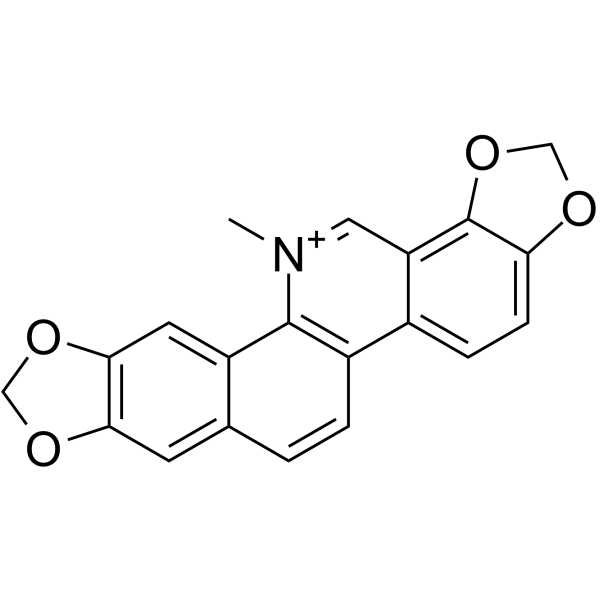上海金畔生物科技有限公司为生命科学和医药研发人员提供生物活性分子抑制剂、激动剂、特异性抑制剂、化合物库、重组蛋白,专注于信号通路和疾病研究领域。
Sanguinarine (Synonyms: 血根碱; Sanguinarin; Sanguinarium; Pseudochelerythrine)
Sanguinarine (Sanguinarin) 是一种来源于 Sanguinaria Canadensis 的生物碱,可通过激活活性氧 (ROS) 的产生来刺激细胞凋亡。Sanguinarine 诱导的细胞凋亡与 JNK 和 NF-κB 的活化有关。

Sanguinarine Chemical Structure
CAS No. : 2447-54-3
| 规格 | 是否有货 | ||
|---|---|---|---|
| 5 mg | 询价 | ||
| 10 mg | 询价 | ||
| 25 mg | 询价 |
* Please select Quantity before adding items.
| 生物活性 |
Sanguinarine (Sanguinarin), a benzophenanthridine alkaloid derived from the root of Sanguinaria Canadensis, can stimulate apoptosis via activating the production of reactive oxygen species (ROS). Sanguinarine-induced apoptosis is associated with the activation of JNK and NF-κB. |
IC50 & Target |
Apoptosis[1] |
|---|---|
| 体外研究 (In Vitro) |
Sanguinarine (SANG)-induced apoptosis is associated with the activation of JNK and NF-κB signal pathways.To determine the effects of Sanguinarine on cell viability, 22B-cFluc cells are stimulated with different concentrations of Sanguinarine for 24 h, and then a CKK-8 assay is performed. The treatment with Sanguinarine decreases the proliferation of 22B cells in a dose-dependent manner. Meanwhile, the cytosolic extracts of 22B-cFluc cells treated with different dose of Sanguinarine are measured to detect cellular caspase-3 activity using Ac-DEVD-pNA, which is a validated caspase-3 substrate. The absorbance at 450 nm increases in a dose-dependent manner, indicating increased caspase-3 activity stimulated by Sanguinarine[1]. Shanghai Jinpan Biotech Co Ltd has not independently confirmed the accuracy of these methods. They are for reference only. |
| 体内研究 (In Vivo) |
To evaluate the apoptosis induced by Sanguinarine (SANG) in vivo, 22B-cFluc cells are inoculated subcutaneously into one flank of nude mice and xenograft models are allowed to establish. Mice are treated intravenously with 10 mg/kg of Sanguinarine. At 24, 48 and 72 h after treatment, bioluminescent imaging is performed after i.p. injection of mice with 150 mg/kg of D-luciferin substrate. Sanguinarine treatment induces an obvious increase of luminescent signal as early as 48 h after initial treatment. A sustained bioluminescent imaging (BLI) intensity increased is observed throughout the course of experiment. At 72 h after treatment, the tumors are collected and subjected to TUNEL staining for evaluating apoptosis. Compared with the control tumors, the group treated with Sanguinarine exhibits significantly more cell apoptosis, indicated by the increased green signals from the sporadic apoptotic cells[1]. Shanghai Jinpan Biotech Co Ltd has not independently confirmed the accuracy of these methods. They are for reference only. |
| 分子量 |
332.33 |
| Formula |
C20H14NO4+ |
| CAS 号 |
2447-54-3 |
| 中文名称 |
血根碱;假白屈菜季铵碱 |
| 运输条件 |
Room temperature in continental US; may vary elsewhere. |
| 储存方式 |
Please store the product under the recommended conditions in the Certificate of Analysis. |
| 参考文献 |
|
| Kinase Assay [1] |
The caspase-3 activity is measured using a caspase-3 activity assay kit. Briefly, the cells treated by different concentrations of Sanguinarine (0.5 μM, 1 μM, 2 μM, 4 μM) or control DMSO are collected, washed and lysed in a lysis buffer for 30 min on ice. The supernatants are then collected by centrifuging at 1,2000 rpm for 10 min. The Ac-DEVD-pNA (2 mM) is added to each sample and incubated at 37°C for 1 h. The optical density (OD) of each sample is finally quantified at a wavelength of 405 nm using a spectrophotometer. The p-NA standard is used to calibrate the caspase-3 activity of each sample[1]. Shanghai Jinpan Biotech Co Ltd has not independently confirmed the accuracy of these methods. They are for reference only. |
|---|---|
| Cell Assay [1] |
The cell viability of Sanguinarine is determined by CCK-8 assay using a cell counting kit-8. Briefly, 22B-cFluc cells are seeded in a 96-well plate (5×103 cells/well) and treated with different concentrations of Sanguinarine (0.5 μM, 1 μM, 2 μM, 4 μM) for 24 h. Then 10 mL CKK-8 is added to each well for 4 h and the absorbance at 450 nm is measured with a microplate reader. The optical density (OD) values are determined to reflect the viable cell populations from each well[1]. Shanghai Jinpan Biotech Co Ltd has not independently confirmed the accuracy of these methods. They are for reference only. |
| Animal Administration [1] |
Mice[1] Shanghai Jinpan Biotech Co Ltd has not independently confirmed the accuracy of these methods. They are for reference only. |
| 参考文献 |
|
所有产品仅用作科学研究或药证申报,我们不为任何个人用途提供产品和服务
